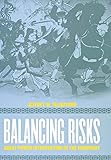Balancing Risks : Great Power Intervention in the Periphery / Jeffrey W. Taliaferro.
Material type: TextSeries: Cornell Studies in Security AffairsPublisher: Ithaca, NY : Cornell University Press, [2019]Copyright date: ©2004Description: 1 online resource (336 p.) : 8 tables, 1 line drawingContent type:
TextSeries: Cornell Studies in Security AffairsPublisher: Ithaca, NY : Cornell University Press, [2019]Copyright date: ©2004Description: 1 online resource (336 p.) : 8 tables, 1 line drawingContent type: - 9780801442216
- 9781501720253
- 327.1/09/04 22
- online - DeGruyter
- Issued also in print.
| Item type | Current library | Call number | URL | Status | Notes | Barcode | |
|---|---|---|---|---|---|---|---|
 eBook
eBook
|
Biblioteca "Angelicum" Pont. Univ. S.Tommaso d'Aquino Nuvola online | online - DeGruyter (Browse shelf(Opens below)) | Online access | Not for loan (Accesso limitato) | Accesso per gli utenti autorizzati / Access for authorized users | (dgr)9781501720253 |
Frontmatter -- CONTENTS -- Tables and Figures -- Acknowledgments -- Abbreviations -- Note on Translations, Romanization, and Stylistic Conventions -- 1. Power Politics and the Balance of Risk -- 2. Explaining Great Power Involvement in the Periphery -- 3. Germany and the 1905 Morocco Crisis -- 4. Japan and the 1940-41 War Decisions -- 5. The United States and the Korean War (1950-51) -- 6. The Limits of Great Power Intervention in the Periphery -- 7. Implications of the Argument -- Notes -- Index
restricted access online access with authorization star
http://purl.org/coar/access_right/c_16ec
Great powers often initiate risky military and diplomatic inventions in far-off, peripheral regions that pose no direct threat to them, risking direct confrontation with rivals in strategically inconsequential places. Why do powerful countries behave in a way that leads to entrapment in prolonged, expensive, and self-defeating conflicts? Jeffrey W. Taliaferro suggests that such interventions are driven by the refusal of senior officials to accept losses in their state's relative power, international status, or prestige. Instead of cutting their losses, leaders often continue to invest blood and money in failed excursions into the periphery. Their policies may seem to be driven by rational concerns about power and security, but Taliaferro deems them to be at odds with the master explanation of political realism. Taliaferro constructs a "balance-of-risk" theory of foreign policy that draws on defensive realism (in international relations) and prospect theory (in psychology). He illustrates the power of this new theory in several case narratives: Germany's initiation and escalation of the 1905 and 1911 Moroccan crises, the United States' involvement in the Korean War in 1950-52, and Japan's entanglement in the second Sino-Japanese war in 1937-40 and its decisions for war with the U.S. in 1940-41.
Issued also in print.
Mode of access: Internet via World Wide Web.
In English.
Description based on online resource; title from PDF title page (publisher's Web site, viewed 02. Mrz 2022)


